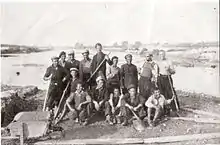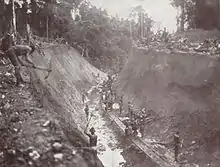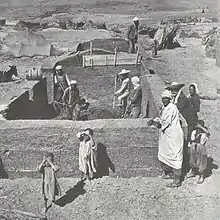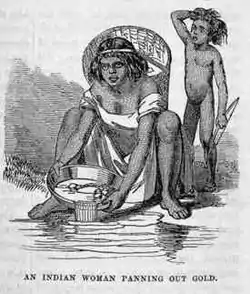Unfree labour
Unfree labour (or forced labour) is any work relation, especially in modern or early modern history, in which people are employed against their will with the threat of destitution, detention, violence (including death), compulsion,[1] or other forms of extreme hardship to themselves or members of their families.

| Part of a series on |
| Slavery |
|---|
 |
Unfree labour includes all forms of slavery, penal labour and the corresponding institutions, such as debt slavery, serfdom, corvée and labour camps.
Definition
Many forms of unfree labor are also covered by the term forced labour, which is defined by the International Labour Organization (ILO) as all involuntary work or service exacted under the menace of a penalty.[2]
However, under the ILO Forced Labour Convention of 1930, the term forced or compulsory labour shall not include:[3]
- "any work or service exacted in virtue of compulsory military service laws for work of a purely military character;"
- "any work or service which forms part of the normal civic obligations of the citizens of a fully self-governing country;"
- "any work or service exacted from any person as a consequence of a conviction in a court of law, provided that the said work or service is carried out under the supervision and control of a public authority and that the said person is not hired to or placed at the disposal of private individuals, companies or associations (requiring that prison farms no longer do convict leasing)";
- "any work or service exacted in cases of emergency, that is to say, in the event of war, of a calamity or threatened calamity, such as fire, flood, famine, earthquake, violent epidemic or epizootic diseases, invasion by: animal, insect or vegetable pests, and in general any circumstance that would endanger the existence or the well-being of the whole or part of the population";
Payment for unfree labour

If payment occurs, it may be in one or more of the following forms:
- The payment does not exceed subsistence or barely exceeds it;
- The payment is in goods which are not desirable and/or cannot be exchanged or are difficult to exchange; or
- The payment wholly or mostly consists of cancellation of a debt or liability that was itself coerced, or belongs to someone else.
Unfree labour is often more easily instituted and enforced on migrant workers, who have traveled far from their homelands and who are easily identified because of their physical, ethnic, linguistic, or cultural differences from the general population, since they are unable or unlikely to report their conditions to the authorities.[4]
Industrial involvement

In many contexts, the use of unfree labour is prohibited under the law and is mainly associated with the black economy. In other contexts, established industries have embraced the use of unfree labour as a socially accepted practice in that time and place. Use of compelled labour is especially common when the labour involved can not be performed without risk of death, disfigurement, disability, or diminished life expectancy; in the extreme, these detriments render the voluntary labour market uneconomic, and the industry in question is forced to either adopt compelled labour or discontinue operations altogether.
Industries which continue to employ unfree labour worldwide include agriculture, domestic work, manufacture, and hospitality.[5] Mining, defense, the merchant marine and transportation infrastructure, which employed questionable practices during the heydays of railway track construction (often involving the use of high explosives or constructing high wooden trestle bridges in sheer mountain canyons), and of canal excavation (sometimes in conditions of permafrost) also have historical ties.
Modern day unfree labour

Unfree labor re-emerged as an issue in the debate about rural development during the years following the end of the Second World War, when a political concern of Keynesian theory was not just economic reconstruction (mainly in Europe and Asia) but also planning (in developing "Third World" nations). A crucial aspect of the ensuing discussion concerned the extent to which different relational forms constituted obstacles to capitalist development, and why.
During the 1960s and 1970s unfree labor was regarded as incompatible with capitalist accumulation, and thus an obstacle to economic growth, an interpretation advanced by exponents of the then-dominant semi-feudal thesis. From the 1980s onwards, however, another and very different Marxist view emerged, arguing that evidence from Latin America and India suggested agribusiness enterprises, commercial farmers and rich peasants reproduced, introduced or reintroduced unfree relations.
However, recent contributions to this debate have attempted to exclude Marxism from the discussion. These contributions maintain that, because Marxist theory failed to understand the centrality of unfreedom to modern capitalism, a new explanation of this link is needed. This claim has been questioned by Tom Brass (2014), ‘Debating Capitalist Dynamics and Unfree Labour: A Missing Link?’, The Journal of Development Studies, 50:4, 570–82. He argues that many of these new characteristics are in fact no different from those identified earlier by Marxist theory and that the exclusion of the latter approach from the debate is thus unwarranted.
The International Labour Organization (ILO) estimates that at least 12.3 million people are victims of forced labour worldwide; of these, 9.8 million are exploited by private agents and more than 2.4 million are trafficked. Another 2.5 million are forced to work by the state or by rebel military groups.[6][7] From an international law perspective, countries that allow forced labor are violating international labour standards as set forth in the Abolition of Forced Labour Convention (C105), one of the fundamental conventions of the ILO.[8]
According to the ILO Special Action Programme to Combat Forced Labour (SAP-FL), global profits from forced trafficked labour exploited by private agents are estimated at US$44,3 billion per year. About 70% of this value (US$31.6 billion) come from trafficked victims. At least the half of this sum (more than US$15 billion) comes from industrialized countries.[9]
Trafficking
Trafficking is a term to define the recruiting, harbouring, obtaining and transportation of a person by use of force, fraud, or coercion for the purpose of subjecting them to involuntary acts, such as acts related to commercial sexual exploitation (including forced prostitution) or involuntary labour.[10]
Forms of unfree labour

Slavery
The archetypal and best-known form of unfree labour is chattel slavery, in which individual workers are legally owned throughout their lives, and may be bought, sold or otherwise exchanged by owners, while never or rarely receiving any personal benefit from their labour. Slavery was common in many ancient societies, including ancient Egypt, Babylon, Persia, ancient Greece, Rome, ancient Israel, ancient China, classical Arab states, as well as many societies in Africa and the Americas. Being sold into slavery was a common fate of populations that were conquered in wars. Perhaps the most prominent example of chattel slavery was the enslavement of many millions of black people in Africa, as well as their forced transportation to the Americas, Asia, or Europe, where their status as slaves was almost always inherited by their descendants.
The term "slavery" is often applied to situations which do not meet the above definitions, but which are other, closely related forms of unfree labour, such as debt slavery or debt-bondage (although not all repayment of debts through labour constitutes unfree labour). Examples are the Repartimiento system in the Spanish Empire, or the work of Indigenous Australians in northern Australia on sheep or cattle stations (ranches), from the mid-19th to the mid-20th century. In the latter case, workers were rarely or never paid, and were restricted by regulations and/or police intervention to regions around their places of work.
In late 16th century Japan, "unfree labour" or slavery was officially banned; but forms of contract and indentured labour persisted alongside the period's penal codes' forced labour. Somewhat later, the Edo period's penal laws prescribed "non-free labour" for the immediate families of executed criminals in Article 17 of the Gotōke reijō (Tokugawa House Laws), but the practice never became common. The 1711 Gotōke reijō was compiled from over 600 statutes that were promulgated between 1597 and 1696.[11]
According to Kevin Bales in Disposable People: New Slavery in the Global Economy (1999), there are now an estimated 27 million slaves in the world.[12][13]
Truck system
A truck system, in the specific sense in which the term is used by labour historians, refers to an unpopular or even exploitative form of payment associated with small, isolated and/or rural communities, in which workers or self-employed small producers are paid in either: goods, a form of payment known as truck wages, or tokens, private currency ("scrip") or direct credit, to be used at a company store, owned by their employers. A specific kind of truck system, in which credit advances are made against future work, is known in the U.S. as debt bondage.
Many scholars have suggested that employers use such systems to exploit workers and/or indebt them. This could occur, for example, if employers were able to pay workers with goods which had a market value below the level of subsistence, or by selling items to workers at inflated prices. Others argue that truck wages, at least in some cases, were a convenient way for isolated communities to operate, when official currency was scarce.
By the early 20th century, truck systems were widely seen, in industrialised countries, as exploitative; perhaps the most well-known example of this view was a 1947 U.S. hit song "Sixteen Tons". Many countries have Truck Act legislation that outlaws truck systems and requires payment in cash.
Corvée
Though most closely associated with Medieval Europe, governments throughout human history have imposed regular short stints of unpaid labor upon lower social classes. These might be annual obligations of a few weeks or something similarly regular that lasted for the laborer's entire working life. As the system developed in the Philippines and elsewhere, the laborer could pay an appropriate fee and be exempted from the obligation.
Vetti-chakiri
In vetti-chakiri and begar, lower castes have only had obligations or duties to render free services to the upper caste community, also called vetti or vetti chakiri.[14]
Penal labour
Labour camps

Another historically significant example of forced labour was that of political prisoners, people from conquered or occupied countries, members of persecuted minorities, and prisoners of war, especially during the 20th century. The best-known example of this are the concentration camp system run by Nazi Germany in Europe during World War II, the Gulag camps[15] run by the Soviet Union,[16] and the forced labour used by the military of the Empire of Japan, especially during the Pacific War (such as the Burma Railway). Roughly 4,000,000 German POWs were used as "reparations labour" by the Allies for several years after the German surrender; this was permitted under the Third Geneva Convention provided they were accorded proper treatment.[17] China's laogai ("labour reform") system and North Korea's kwalliso camps are current examples.
About 12 million forced labourers, most of whom were Poles and Soviet citizens (Ost-Arbeiter) were employed in the German war economy inside Nazi Germany.[18][19] More than 2000 German companies profited from slave labour during the Nazi era, including Daimler, Deutsche Bank, Siemens, Volkswagen, Hoechst, Dresdner Bank, Krupp, Allianz, BASF, Bayer, BMW, and Degussa.[20][21]
In Asia, according to a joint study of historians featuring Zhifen Ju, Mark Peattie, Toru Kubo, and Mitsuyoshi Himeta, more than 10 million Chinese were mobilized by the Japanese army and enslaved by the Kōa-in for slave labour in Manchukuo and north China.[22] The U.S. Library of Congress estimates that in Java, between 4 and 10 million romusha (Japanese: "manual laborer") were forced to work by the Japanese military. About 270,000 of these Javanese laborers were sent to other Japanese-held areas in South East Asia. Only 52,000 were repatriated to Java, meaning that there was a death rate of 80%.[23]
Kerja rodi (Heerendiensten), was the term for forced labor in Indonesia during Dutch colonisation.
The Khmer Rouge attempted to turn Cambodia into a classless society by depopulating cities and forcing the urban population ("New People") into agricultural communes. The entire population was forced to become farmers in labour camps.
Prison labour

Convict or prison labour is another classic form of unfree labour. The forced labour of convicts has often been regarded with lack of sympathy, because of the social stigma attached to people regarded as "common criminals". In some countries and historical periods, however, prison labour has been forced upon people who have been victims of prejudice, convicted of political crimes, convicted of "victimless crimes", or people who committed theft or related offences because they lacked any other means of subsistence—categories of people who typically are entitled to compassion according to current ethical ideas.
Three British colonies in Australia—New South Wales, Van Diemen's Land (Tasmania) and Western Australia—are three examples of the state use of convict labour. Australia received thousands of convict labourers in the eighteenth and nineteenth centuries who were given sentences for crimes ranging from those now considered to be minor misdemeanors to such serious offences as murder, rape and incest. A considerable number of Irish convicts were sentenced to transportation for 'treason' while fighting for Irish independence from British rule.
More than 165,000 convicts were transported to Australian colonies from 1788 to 1868.[24] Most British or Irish convicts who were sentenced to transportation, however, completed their sentences in British jails and were not transported at all.
It is estimated that in the last 50 years more than 50 million people have been sent to Chinese laogai camps.[25]
Indentured and bonded labour
A more common form in modern society is indenture, or bonded labour, under which workers sign contracts to work for a specific period of time, for which they are paid only with accommodation and sustenance, or these essentials in addition to limited benefits such as cancellation of a debt, or transportation to a desired country.
Permitted exceptions of unfree labour
As mentioned above, there are several exceptions of unfree or forced labour recognized by the International Labour Organization:
Civil Conscription
Some countries practice forms of civil conscription for different major occupational groups or inhabitants under different denominations like civil conscription, civil mobilization, political mobilisation etc. This obligatory services on the one hand has been implemented due to long-lasting labour strikes, during wartimes or economic crisis, to provide basic services like medical care, food supply or supply of the defense industry. On the other hand this service can be obligatory to provide recurring and inevitable services to the population, like fire services, due to lack of volunteers.
Temporary civil conscription
Between December 1943 and March 1948 young men in the United Kingdom, the so-called Bevin Boys, had been conscripted for the work in coal mines.[26] In Belgium in 1964, in Portugal and in Greece from 2010 to 2014 due to the severe economic crisis, a system of civil mobilization was implemented to provide public services as a national interest. In Greece these obligatory services have been called political mobilization) and civil conscription.[27][28][29][30]
Recurring civil conscription
In Switzerland in most communities for all inhabitants, no matter if they are Swiss or not, it is mandatory to join the so-called Militia Fire Brigades, as well as the obligatory service in Swiss civil defense and protection force. Conscripts in Singapore are providing the personnel of the country's fire service as part of the national service in the Civil Defence Force. In Austria and Germany citizens have to join a compulsory fire brigade if a volunteer fire service can not be provided, due to lack of volunteers. In 2018 this regulation is executed only in a handful of communities in Germany and currently none in Austria.[31][32][33]
Conscription for military service and security forces
Beside the conscription for military services, some countries draft citizens for paramilitary or security forces, like internal troops, border guards or police forces. While sometimes paid, conscripts are not free to decline enlistment. Draft dodging or desertion are often met with severe punishment. Even in countries which prohibit other forms of unfree labour, conscription is generally justified as being necessary in the national interest and therefore it is not contrary to the exceptions of the Forced Labour Convention, signed by the most countries in the world.
Community services
Community service is a non-paying job performed by one person or a group of people for the benefit of their community or its institutions. Community service is distinct from volunteering, since it is not always performed on a voluntary basis. Although personal benefits may be realized, it may be performed for a variety of reasons including citizenship requirements, a substitution of criminal justice sanctions, requirements of a school or class, and requisites for the receipt of certain benefits.
De facto obligatory community work
During the Cold War in some communist countries like Czechoslovakia, the German Democratic Republic or the Soviet Union the originally voluntary work on Saturday for the community called Subbotnik, Voskresnik or Akce Z became de facto obligatory for the members of a community.
Hand and hitch-up services
In some German states it is feasible for communities to draft citizens for public services, called Hand and hitch-up services. This mandatory service is still executed to maintain the infrastructure of small communities.[34][35]
International conventions
See also
- Coolitude
- Coolie Trade
- Construction soldier
- Employee abuse
- Debt bondage
- Exploitation
- Forced labor in Germany during World War II
- Forced labor of Germans after World War II
- Involuntary servitude
- Indentured servitude
- Labor army
- Labor battalion
- Labor trafficking in the United States
- List of concentration and internment camps
- NKVD labor columns
- Refusal of work
- SAP-FL, the ILO Special Action Programme to Combat Forced Labour
- Sexual slavery
- Shanghaiing
- Sweatshop
- Trafficking in human beings
- Trafficking of children
- Wage slavery
- Workfare
- Workhouse
Notes
- forced labour under German rule during World War II through Service du travail obligatoire of Vichy France
- Andrees and Belser, "Forced labor: Coercion and exploitation in the private economy", 2009. Rienner and ILO.
- "Convention C029 - Forced Labour Convention, 1930 (No. 29)". www.ilo.org.
- "Thailand: Sea Slavery - TheOutlawOcean". Youtube. Retrieved 26 October 2020.
- Wilder, Danyella (19 December 2018). "Top 5 Industries using Forced Labor". dressember.org. Dressember. Retrieved 25 May 2020.
- "Forced labour". Ilo.org. 2013-02-15. Retrieved 2013-03-20.
- Trafficking for Forced Labour in Europe—Report on a study in the UK, Ireland the Czech Republic and Portugal. Archived 2012-01-13 at the Wayback Machine November, 2006.
- "Abolition of Forced Labour Convention, 1957 (No. 105)". International Labour Organization. Retrieved 24 October 2013.
- Forced Labour and Human trafficking: Estimating the Profits.
- "What Is Human Trafficking?". Department of Homeland Security. Retrieved 6 March 2017.
- Lewis, James Bryant. (2003). Frontier Contact Between Choson Korea and Tokugawa Japan, pp. 31–32.
- "Slavery in the Twenty-First Century". Un.org. Retrieved 2013-03-20.
- "Millions 'forced into slavery'". BBC News. 2002-05-27. Retrieved 2013-03-20.
- "ewcwwp013.pdf" (PDF). docs.google.com.
- Gulag, Encyclopædia Britannica
- The Gulag Collection: Paintings of Nikolai Getman Archived 2007-10-31 at the Wayback Machine.
- "The original memorandum from 1944, signed by Morgenthau". Fdrlibrary.marist.edu. 2004-05-27. Retrieved 2013-03-20.
- "Final Compensation Pending for Former Nazi Forced Laborers". Dw-world.de. Retrieved 2013-03-20.
- "Forced Labor at Ford Werke AG during the Second World War". Archived from the original on October 14, 2007.
- American Jewish Committee (2000). "German Firms That Used Slave Or Forced Labor During the Nazi Era", webpage of Jewish Virtual Library. Retrieved October 21, 2007.
- Roger Cohen (1999-02-17). "German Companies Adopt Fund For Slave Laborers Under Nazis". New York Times. Retrieved 2013-03-20.
- Zhifen Ju, "Japan's atrocities of conscripting and abusing north China draftees after the outbreak of the Pacific war", 2002
- Library of Congress, 1992, "Indonesia: World War II and the Struggle For Independence, 1942–50; The Japanese Occupation, 1942–45" Access date: February 9, 2007.
- Convict Records, Ancestry.co.uk
- Lewis, Aaron (October 5, 2005). "Inside the Lao Gai". Special Broadcasting Service Archived 2008-09-13 at the Wayback Machine. Retrieved on 2008-10-16.
- "Bevin Boys - BIS". 3 July 2009. Archived from the original on 3 July 2009.
- "CIVIL CONSCRIPTION - Eurofound". www.eurofound.europa.eu.
- "'Νόμιμη η επιστράτευση των ναυτεργατών' - BBC Greek". www.bbc.co.uk.
- "Greek gov't to issue 86,000 'civil mobilization' orders for teachers …before the strike".
- "Archived copy". Archived from the original on 2017-03-18. Retrieved 2018-12-27.CS1 maint: archived copy as title (link)
- ume. "Personalmangel: Pflicht-Feuerwehr für Friedrichstadt - shz.de". shz.
- NDR. "Nachrichten aus Norddeutschland". www.ndr.de.
- "Home :: Swissfire Feuerwehrverband". www.swissfire.ch.
- https://dejure.org/gesetze/GemO/10.html
- "Art 12 GG - Einzelnorm". www.gesetze-im-internet.de.
References
- Allen, Theodore W. (1994). The Invention of the White Race: Racial Oppression and Social Control. New York: Verso Books. ISBN 978-0-86091-480-8 (cloth) -- ISBN 978-0-86091-660-4 (paper)
- Allen, Theodore W. (1997). The Invention of the White Race: The Origin of Racial Oppression in Anglo-America, 1997. New York: Verso Books. ISBN 978-1-85984-981-1 (cloth) -- ISBN 978-1-85984-076-4 (paper)
- Bales, Kevin. (1999). Disposable People: New Slavery in the Global Economy. Berkeley: University of California Press. ISBN 0-520-22463-9
- Brass, Tom, Marcel Van Der Linden, and Jan Lucassen. (1993). Free and Unfree Labour. Amsterdam: International Institute for Social History. ISBN 978-3-906756-87-5
- Brass, Tom. (1999). Towards a Comparative Political Economy of Unfree Labour: Case Studies and Debates. London: Frank Cass Publishers. ISBN 978-0-7146-4938-2 (cloth) -- ISBN 978-0-7146-4498-1 (paper)
- Brass, Tom and Marcel Van Der Linden. (1997). Free and Unfree Labour: The Debate Continues. New York: Peter Lang. ISBN 978-0-8204-3424-7 (cloth)
- Brass, Tom. (2011). Labour Regime Change in the Twenty-First Century: Unfreedom, Capitalism and Primitive Accumulation. Leiden: Brill. ISBN 978-90-04-20247-4.
- Brass, Tom. (2017) Labour Markets, Identities, Controversies: Reviews and Essays, 1982-2016. Leiden: Brill. ISBN 978-90-04-32237-0.
- Blackburn. (1997). The Making of New World Slavery From the Baroque to the Modern, 1492–1800, London: Verso Books. ISBN 978-1-85984-195-2 (paper)
- Blackburn, Robin. (1988). The Overthrow of Colonial Slavery, 1776–1848. London: Verso Books. ISBN 978-0-86091-188-3 (cloth) -- ISBN 978-0-86091-901-8 (paper)
- Hilton, George W. (1960). The Truck System, including a History of the British Truck Acts, 1465-1960. Cambridge: W. Heffer & Sons Ltd. [reprinted by Greenwood Press, London, 1975. ISBN 978-0-837-18130-1]
- Lewis, James Bryant. (2003). Frontier Contact Between Choson Korea and Tokugawa Japan. London: Routledge. ISBN 0-7007-1301-8
- Guijarro Morales, A. El Síndrome de la Abuela Esclava. Pandemia del Siglo XXI (The Enslaved Grandmother Syndrome: a 21st-century Pandemic). Grupo Editorial Universitario. Granada, oct 2001. ISBN 978-84-8491-124-1.
- Ruhs, Florian: Foreign Workers in the Second World War. The Ordeal of Slovenians in Germany., in: aventinus nova Nr. 32 [29.05.2011]
- Torabully, Khal and Carter, Marina, Coolitude, Anthem University Press, London, 2002
- Torabully, Khal, Voices from the Aapravasi Ghat, AGTF, Mauritius, 2016
- Torabully, Khal, Cargohold of stars, Seagull, Calcutta, Chicago, USA, 2021
- ILO Minimum Estimate of Forced Labour in the World. (2005)
- The Cost of Coercion ILO 2009
- International Labour Office. (2005). A global alliance against forced labour
- Operational Indicators of Trafficking in Human Beings 2009 ILO/SAP-FL
- Lists of indicators of Trafficking in Human Beings 2009 ILO/SAP-FL
- Eradication of forced labour—General Survey concerning the Forced Labour Convention, 1930 (No. 29), and the Abolition of Forced Labour Convention, 1957 (No. 105) — ILO 2007
- Forced Labour: Definition, Indicators and Measurement 2004 — ILO
- Stopping Forced Labour 2001 — ILO
- Torabully, Khal, The story of the International Indentured Labour Route of UNESCO, https://www.lemauricien.com/le-mauricien/the-story-of-the-international-indentured-labour-route-project-and-its-philosophy/400344/
External links
| Look up forced labor in Wiktionary, the free dictionary. |
| Wikimedia Commons has media related to Unfree labour. |
- UN.GIFT — Global Initiative to Fight Human Trafficking
- Eliminating Forced Labor — Bureau of International Labor Affairs, U.S. Department of Labor
- Slavery in the 21st century—BBC
- Sex trade's reliance on forced labour—BBC
- China's Forced Labour Camps—Laogai Research Foundation
- The ILO Special Action Programme to combat Forced Labour (SAP-FL)
- Alleging Captive Labor, Foreign Students Walk Out of Work-Study Program at Hershey Plant Democracy Now!, September 1, 2011.
- Migrant Workers as Non-Citizens: The Case against Citizenship as a Social Policy Concept, by Donna Baines and Nandita Sharma. Studies in Political Economy 69. Autumn 2002, p. 75.
- Seafood from Slaves - Associated Press investigation of the international Pacific fishing fleet, 2015-2016, winner of the 2016 Pulitzer Prize for Public Service